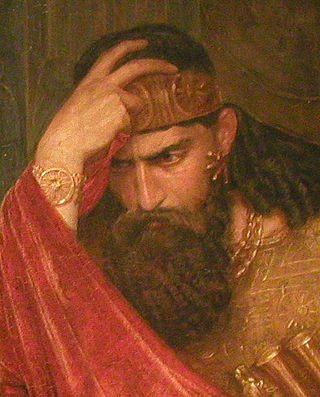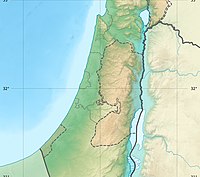
In the Hebrew Bible, Abner was the cousin of King Saul and the commander-in-chief of his army. His name also appears as אבינר בן נר "Abiner son of Ner", where the longer form Abiner means "my father is Ner".

The Book of Samuel is a book in the Hebrew Bible, found as two books in the Old Testament. The book is part of the narrative history of Ancient Israel called the Deuteronomistic history, a series of books that constitute a theological history of the Israelites and that aim to explain God's law for Israel under the guidance of the prophets.

David was, according to the Hebrew Bible, the third king of the United Kingdom of Israel. In the Books of Samuel, he is described as a young shepherd and harpist who gains fame by slaying Goliath, a champion of the Philistines, in southern Canaan. David becomes a favourite of Saul, the first king of Israel; he also forges a notably close friendship with Jonathan, a son of Saul. However, under the paranoia that David is seeking to usurp the throne, Saul attempts to kill David, forcing the latter to go into hiding and effectively operate as a fugitive for several years. After Saul and Jonathan are both killed in battle against the Philistines, a 30-year-old David is anointed king over all of Israel and Judah. Following his rise to power, David conquers the city of Jerusalem and establishes it as Israel's capital, subsequently taking the Ark of the Covenant into the city to be the central point of worship in the Israelite religion.

Saul was, according to the Hebrew Bible, the first monarch of the United Kingdom of Israel. His reign, traditionally placed in the late 11th century BCE, supposedly marked the transition of Israel and Judah from a scattered tribal society to organized statehood.

Gibeon was a Canaanite and, later, an Israelite city which was located north of Jerusalem. According to Joshua 10:12 and Joshua 11:19, the pre-Israelite-conquest inhabitants, the Gibeonites, were Hivites; according to 2 Samuel 21:2 they were Amorites. The remains of Gibeon are located in the southern portion of the Palestinian village of al-Jib.

Mahanaim is a place mentioned a number of times by the Bible said to be near Jabbok, in the same general area as Jabesh-gilead, beyond the Jordan River. Although two possible sites have been identified, the precise location of Mahanaim is uncertain. Tell edh-Dhahab el-Gharbi, the western one of the twin Tulul adh-Dhahab tells, is one proposed identification.

Ish-bosheth, also called Eshbaal was, according to the Hebrew Bible, the second monarch of the Kingdom of Israel who succeeded his father, Saul. He reigned for two years, during which he was at war with David. He was killed by two of his own army captains.

The United Monarchy is a political entity described in the Hebrew Bible as encompassing the territories of the later kingdoms of Israel and Judah under the reigns of Saul, David, and Solomon. Whether the United Monarchy actually existed is a matter of ongoing academic debate, and scholars remain divided between those who support the historicity of the biblical narrative, those who doubt or dismiss it, and those who support the kingdom's theoretical existence while maintaining that the biblical narrative is exaggerated. Proponents of the kingdom's existence traditionally date it to between c. 1047 BCE and c. 930 BCE.
Doeg was an Edomite, chief herdsman to Saul, King of Israel. He is mentioned in the Hebrew Bible book of First Samuel, chapters 21 and 22, where he is depicted as an antagonist of David responsible for the deaths of a large number of priests.

Asahel was a military leader under King David and the youngest son of David's sister Zeruiah. Asahel thus was the nephew of David and the younger brother of David's general, Joab, Asahel is mentioned in 2 Samuel chapters 2 and 3.

Champion warfare refers to a type of battle, most commonly found in the epic poetry and myth of ancient history, in which the outcome of the conflict is determined by single combat, an individual duel between the best soldiers ("champions") from each opposing army. Champion warfare can also refer to a battle in which armies actually engage, but champions within the armies fight so effectively as to single-handedly carry the sway of battle, such as in the Iliad.

Palti, son of Laish, who was from Gallim, was the second husband of Michal, Saul's daughter. Where other versions read "Palti" and "Paltiel", the KJV has Phalti and Phaltiel, respectively.
The Ophel pithos is a 3,000-year-old inscription on a fragment of a ceramic jar found near Jerusalem's Temple Mount by Israeli archeologist Eilat Mazar.

2 Samuel 5 is the fifth chapter of the Second Book of Samuel in the Old Testament of the Christian Bible or the second part of Books of Samuel in the Hebrew Bible. According to Jewish tradition the book was attributed to the prophet Samuel, with additions by the prophets Gad and Nathan, but modern scholars view it as a composition of a number of independent texts of various ages from c. 630–540 BCE. This chapter contains the account of David's reign in Hebron and Jerusalem. This is within a section comprising 1 Samuel 16 to 2 Samuel 5 which records the rise of David as the king of Israel, and a section comprising 2 Samuel 2–8 which deals with the period when David set up his kingdom.

The Davidiad is the name of an heroic epic poem in Renaissance Latin by the Croatian national poet and Renaissance humanist Marko Marulić. Likely finished in AD 1517, the poem, as its Latin title suggests, details the ascension and deeds of David, the second king of the United Kingdom of Israel and Judah, who is said to have reigned c. 1010–970 BC.

2 Samuel 2 is the second chapter of the Second Book of Samuel in the Old Testament of the Christian Bible or the second part of Books of Samuel in the Hebrew Bible. According to Jewish tradition the book was attributed to the prophet Samuel, with additions by the prophets Gad and Nathan, but modern scholars view it as a composition of a number of independent texts of various ages from c. 630–540 BCE. This chapter contains the account of David becoming king over Judah in Hebron. This is within a section comprising 1 Samuel 16 to 2 Samuel 5 which records the rise of David as the king of Israel, and a section comprising 2 Samuel 2–8 which deals with the period when David set up his kingdom.

2 Samuel 3 is the third chapter of the Second Book of Samuel in the Old Testament of the Christian Bible or the second part of Books of Samuel in the Hebrew Bible. According to Jewish tradition the book was attributed to the prophet Samuel, with additions by the prophets Gad and Nathan, but modern scholars view it as a composition of a number of independent texts of various ages from c. 630–540 BCE. This chapter contains the account of David's reign in Hebron. This is within a section comprising 1 Samuel 16 to 2 Samuel 5 which records the rise of David as the king of Israel, and a section comprising 2 Samuel 2–8 which deals with the period when David set up his kingdom.

2 Samuel 4 is the fourth chapter of the Second Book of Samuel in the Old Testament of the Christian Bible or the second part of Books of Samuel in the Hebrew Bible. According to Jewish tradition the book was attributed to the prophet Samuel, with additions by the prophets Gad and Nathan, but modern scholars view it as a composition of a number of independent texts of various ages from c. 630–540 BCE. This chapter contains the account of David's reign in Hebron. This is within a section comprising 1 Samuel 16 to 2 Samuel 5 which records the rise of David as the king of Israel, and a section comprising 2 Samuel 2–8 which deals with the period when David set up his kingdom.

Warfare in the Hebrew Bible concerns any military engagement narrated or discussed in the Hebrew Bible, also known as the Tanakh or Old Testament of the Bible. Texts about warfare in the Hebrew Bible are part of the broader topic of The Bible and violence. They cover a wide range of topics from detailed battle reports including weapons and tactics used, numbers of combatants involved, and casualties experienced, to discussions of motives and justifications for war, the sacred and secular aspects of warfare, descriptions and considerations of what in modern times would be considered war crimes such as genocide or wartime sexual violence, and reflections on wars that have happened, or predictions, visions or imaginations of wars that are yet to come.

According to the Torah, the Tribe of Benjamin was one of the Twelve Tribes of Israel. The tribe was descended from Benjamin, the youngest son of the patriarch Jacob and his wife Rachel. In the Samaritan Pentateuch the name appears as Binyamīm.

















